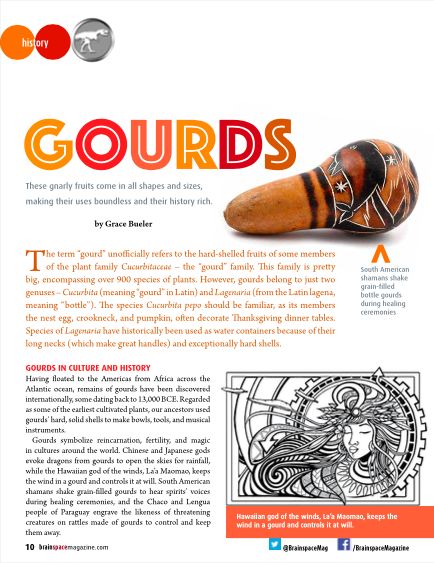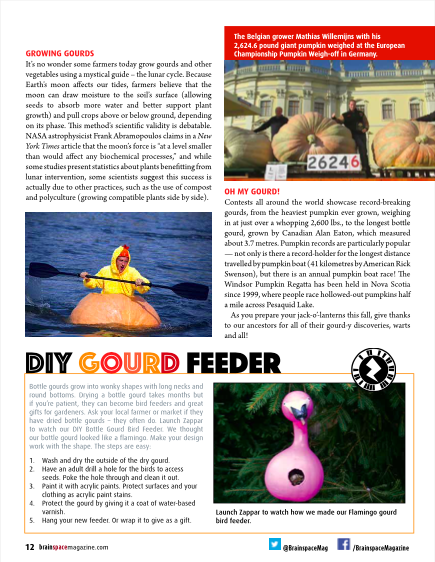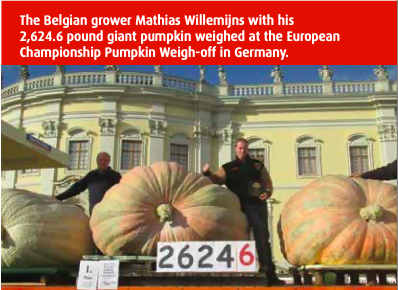
These gnarly fruits come in all shapes and sizes, making their uses boundless and their history rich.



The term “gourd” unofficially refers to the hard-shelled fruits of some members of the plant family Curbitaceae – the “gourd” family. This family is pretty big, encompassing over 900 species of plants. However, gourds belong to just two genuses – Cucurbita (meaning “gourd” in Latin) and Lagenaria (from the Latin lagena, meaning “bottle”). The species Cucurbita pepo should be familiar, as its members the nest egg, crookneck, and pumpkin, often decorate Thanksgiving dinner tables. Species of Lagenaria have historically been used as water containers because of their long necks (which make great handles) and exceptionally hard shells.
GOURDS IN CULTURE AND HISTORY
Having floated to the Americans from Africa across the Atlantic Ocean, remains of gourds have been discovered internationally, some dating back to 13,000 BCE. Regarded as some of the earliest cultivated plants, our ancestors used gourds’ hard, solid shells to make bowls, tools, and musical instruments.
Gourds symbolize reincarnation, fertility, and magic in cultures around the world. Chinese and Japenese gods evoke dragons from gourds to open the skies for rainfall, while the Hawaiian god of the winds, La’a Maomao, keeps the wind in a gourd and controls it at will. South American shamans shake grain-filled gourds to hear spirits’ voices during healing ceremonies, and the Chaco and Lengua people of Paraguay engrave the likeness of gourds to control and keep them away.

The Chinese word for gourd is hu lu which means a holder of precious things. Chinese and Japanese gods evoke dragons from gourds to open the skies for rainfall.
The Chaco and Lengua people of Paraguay engrave the likeness of threatening creatures on rattles made of gourds to control and keep them away.
In Paraguay, a cup from a gourd is called a maté (mah-tay), which is also the name of the tea-infused drink that is served in it. “I’ll have a maté in a maté please!”
In Africa, gourds are useful tools. Also known as calabashes, the gourds are hollowed-out, dried and carved. They are used as containers to store food, wash rice, and carry water. Calabashes are also engineered into drums for music.
GROWING GOURDS
It’s no wonder some farmers today grow gourds and other vegetables using mystical guide – the lunar cycle. Because Earth’s moon affects our tides, farmers believe that that moon can draw moisture to the soil’s surface (allowing seeds to absorb more water and better support plant growth) and pull crops above or below ground, depending on its phase. This method’s scientific validity is debatable. NASA astrophysicist Frank Abramopoulos claims in a New York Times article that the moon’s force is “at a level smaller than would affect any biochemical processes,” and while some studies present statistics about plants benefitting from lunar intervention, some scientists suggest this success is actually due to other practices, such as the use of compost and polyculture (growing compatible plants side by side).

OH MY GOURD!
Contests all aorund the world showcase record-breaking goursa, from the heaviest pumpkin ever grown, weighing in at just over a whopping 2,600 lbs., to the longest bottle groud, grown by Canadian Alan Eaton, which measured about 3.7 metres. Pumpkin record are particularly popular – not only is there a record-holder for the longest distance travelled by pumpkin boat (41 kilometers by American Rick Swenson), but there is an annual pumpkin boat race! The Windsor Pumpkin Regatta has been held in Nova Scotia since 1999, where people race hollowed-out pumpkins half a mile across Pesaquid Lake. As you prepare your jack-o-lanters this fall, give thanks to our ancestors for all their gour-y discoveries, warts and all!


